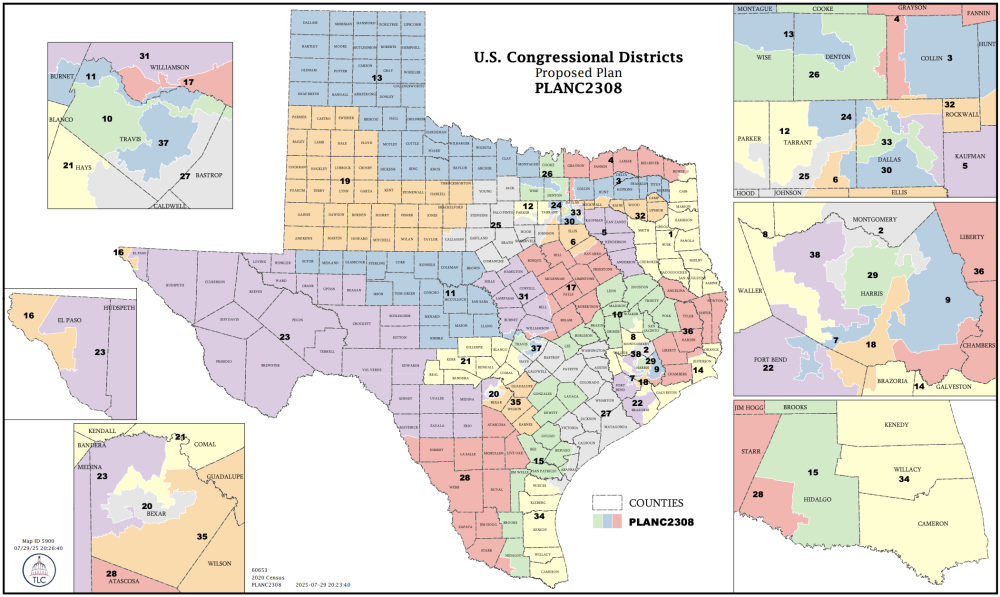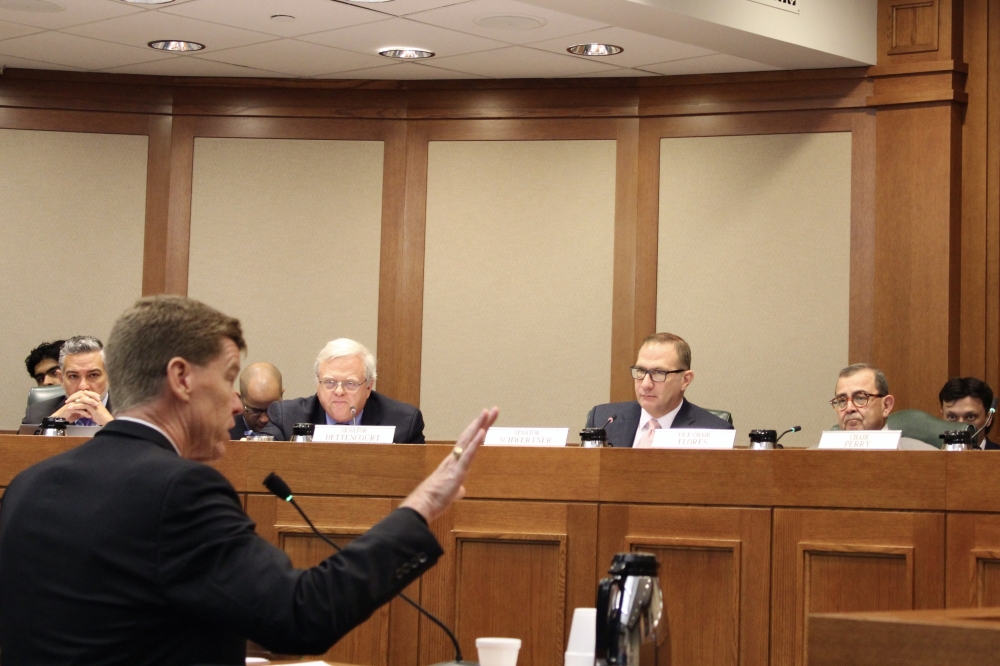The bills face an unclear future in the Texas House, which has been at a standstill since dozens of Democrats traveled to Illinois and other states Aug. 3 to stall a planned vote on the proposed congressional map. The 150-member House cannot refer bills to committees or vote on legislation without at least 100 members present.
If House Democrats do not return, state leaders said the current special legislative session will end Aug. 15. Gov. Greg Abbott said he would “immediately” call another legislative overtime with a potentially expanded agenda.
“Let me be clear: the Texas Senate will keep passing the bills on Gov. Abbott’s call, special session after special session, over and over again, until House Democrats return to fulfill their duty to the people of Texas,” Lt. Gov. Dan Patrick, who leads the Senate, said in an Aug. 12 statement.
House Democrats said they would release a list of demands for the second special session Aug. 15, urging Republican leaders to focus solely on helping communities recover from the deadly July 4-5 flooding instead of passing the redistricting plan in tandem.
“Abbott can choose to govern for Texas families, or he can keep serving Trump and face the consequences we’ve unleashed nationwide,” House Democratic Caucus Chair Rep. Gene Wu, D-Houston, said in an Aug. 13 statement.
Zooming in
State senators passed the proposed congressional map with a 19-2 vote Aug. 12. Nine Senate Democrats left the chamber as the proposal was taken up, in protest of what they deemed “a corrupt process.”
Speaking to reporters outside the chamber, Senate Democrats said they wanted to “stand in solidarity” with quorum-breaking House members. To deny a quorum in the upper chamber, all 11 Democrats would have had to walk out.
Sen. Nathan Johnson, D-Dallas, said that while other states also craft their congressional districts to benefit the majority party, “Democrats don't do it mid-decennial.”
All states are constitutionally required to redistrict every 10 years, after a census, although mid-decade redistricting is not unprecedented. In 2003, Texas lawmakers also redrew the state's congressional map, leading Democrats to travel to Oklahoma in protest.
Texas Republicans have said the current redistricting effort is aimed at netting up to five additional U.S. House seats for Republicans during the 2026 midterm elections.
The lawmakers leading the redistricting push—Sen. Phil King, R-Weatherford, and Rep. Todd Hunter, R-Corpus Christi—have said that 37 of Texas’ 38 congressional districts were redrawn “to some degree,” with the primary changes focused on five districts:
- TX-09, served by U.S. Rep. Al Green, D-Houston
- TX-28, served by U.S. Rep. Henry Cuellar, D-Laredo
- TX-32, served by U.S. Rep. Julie Johnson, D-Farmers Branch
- TX-34, served by U.S. Rep. Vicente Gonzalez, D-McAllen
- TX-35, served by U.S. Rep. Greg Casar, D-Austin

Texas Democrats have called the congressional map “unconstitutional,” arguing that it would split up communities and “dilute” minorities’ voting power. Republicans have countered that race was not a factor when drawing the proposed map, which is designed to “elect more Republicans to the U.S. Congress.”
“All the testimony that's been suggesting that this map was drawn on a racial basis is inaccurate and incorrect,” King said during an Aug. 7 committee hearing. “So I'm disregarding that part of the testimony because I didn't take race into account, and I don't see race in this map.”
King told senators Aug. 12 that his goal was to ensure “the plan before you today be legal in every respect, and it is.”
“No one has presented data, or frankly any compelling case that this map violates any applicable laws,” King said on the Senate floor.
More details
After most Senate Democrats returned to the floor Aug. 12, the upper chamber unanimously passed three bills aimed at providing relief to Central Texas communities that flooded in early July and improving preparedness for future disasters.
One of those measures, Senate Bill 1, would make sweeping changes to Texas’ emergency management framework. Bill author Sen. Charles Perry, R-Lubbock, said it would help fill gaps in local disaster response and recovery efforts.
“SB 1 is going to be used for all natural disasters,” Perry told senators Aug. 12. “It establishes a backbone of disaster relief, recovery and preparedness ... at the local level, to have those responsibilities clear and defined pre-disaster and have those individuals trained in a way that when those events occur, there's no guessing as to who's doing what or what needs to be done.”
During a July 31 legislative hearing, Kerr County’s top three emergency managers told lawmakers they were sleeping when floodwaters rose during the early hours of July 4. Kerr County Judge Rob Kelly said he was at a lakehouse on Lake Travis when the storm struck, while the local sheriff and emergency management coordinator said it was “too late” to order an evacuation by the time they awoke.
“None of us want to be pointing fingers, [but] everyone was here that day ... and you were nowhere to be found,” Patrick told Kelly July 31. “You should have been here directing the response—that’s your responsibility.”
SB 1 would require that all local emergency management coordinators become licensed and complete annual training after Nim Kidd, Texas Division of Emergency Management chief, told lawmakers July 23 that there are “no minimum qualifications” to lead a city or county’s emergency response. Local governments would also be required to follow chains of command to ensure someone is in charge of disaster response if a county judge or mayor is “absent, ... incapacitated, deceased, or otherwise unavailable.”
Perry’s bill would also:
- Require summer camps and campgrounds located near waterways to create flash flood evacuation plans
- Expand mass fatality training for local justices of the peace
- Establish a statewide volunteer management database
- Require background checks for most volunteers responding to natural disasters
- Direct a group of meteorological experts to create a statewide system of flood gauges and other meteorological equipment

“I think everyone here recognizes that after watching these rural river systems ... flood warnings are part of what the public needs to hear,” Bettencourt said Aug. 12. “So we're adding an auditory component in these river watersheds to go along with the system alerts that people are getting on their cellphones.”
Leaders from the Upper Guadalupe River Authority, which manages a roughly 38-mile stretch of the Guadalupe River in Kerr County, told lawmakers in July that they do not currently operate any flood warning sirens. UGRA board President William Rector said July 31 that he did not know if sirens would have made a difference in the July 4 flooding, although he later said there was “no question” that such a system could save lives, according to Bettencourt’s office.
SB 3, by Sen. Joan Huffman, R-Houston, would allocate $294 million in flood relief grants, including:
- $200 million to match federal funding from the Federal Emergency Management Agency
- $50 million to help counties impacted by the July 4-5 floods install flood warning sirens and flood gauges
- $24 million to strengthen weather forecasting and flood warning equipment in the Hill Country
- $20 million for a planned swift water rescue training facility in Harris County, which was announced in January
Also of note
Senators also approved a plan to eliminate the State of Texas Assessments of Academic Readiness, or STAAR, and replace it with three shorter exams given at the start, middle and end of the school year. SB 8, also by Bettencourt, passed with a 22-6 vote Aug. 12.
"What gets measured gets fixed, and if the people involved in the process—the student, the teacher and everyone else—can see those results, have them fed back to them quickly, I think it's going to enable teachers to teach the students and not teach to the test," Bettencourt said during an Aug. 6 hearing on the bill.
Other bills advanced by the Senate include:
- SB 6, which would make it a crime to prescribe or provide abortion-inducing medication in Texas
- SB 10, which is aimed at protecting human trafficking victims from being prosecuted for crimes they were forced to commit
- SB 13 and SB 43, which are aimed at reducing barriers to the construction of water conservation and flood control projects
- SB 14, which would limit the public disclosure of police personnel records
- SB 16, which would make changes to the operation and administration of Texas’ court system





